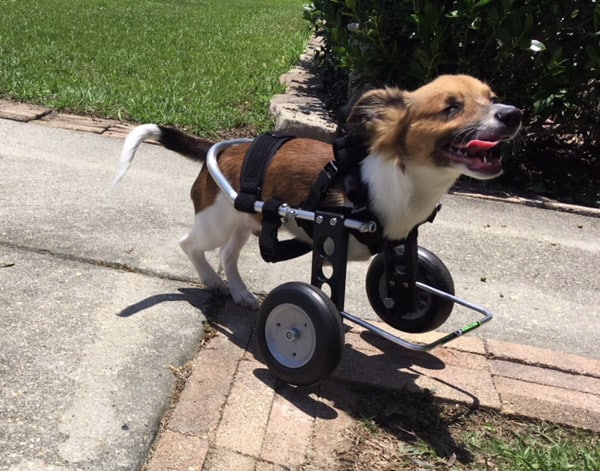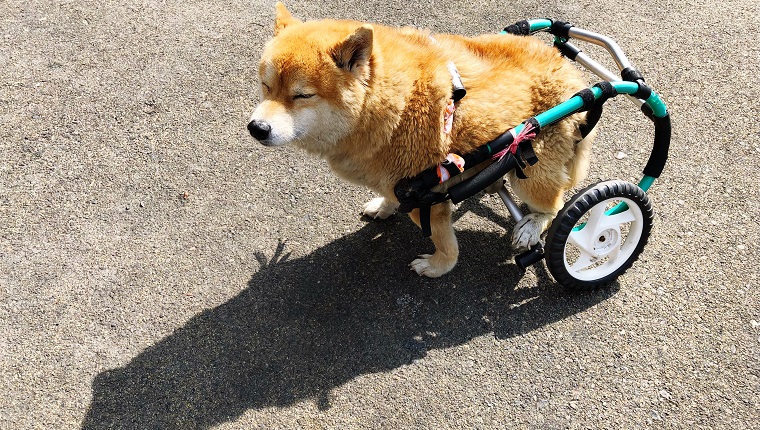Imagine a world where every dog, regardless of their physical limitations, can experience the simple joy of laying down comfortably. In this article, we will explore the fascinating question of whether a dog can lay down in a dog wheelchair. We will delve into the anatomy of these specialized devices, their design considerations, and ultimately uncover the answer to this intriguing query. So, sit back, relax, and join us on this journey into the realm of canine mobility aids.
Overview
Welcome to our comprehensive guide on dog wheelchairs! If your furry friend is experiencing mobility issues or paralysis, a dog wheelchair can provide them with the support and freedom they need to continue living an active and comfortable life. In this article, we will delve into the world of dog wheelchairs, covering everything from their design and features to the benefits they offer. So, let’s get started and ensure your precious pooch can keep wagging their tail!
Understanding Dog Wheelchairs
Dog wheelchairs, also known as dog carts or doggie wheelchairs, are specialized devices designed to assist canines with mobility impairments. These innovative contraptions are made up of a frame, wheels, and a harness system that supports the dog’s hindquarters or all four legs, depending on their needs. By redistributing the weight and providing support, dog wheelchairs enable dogs to walk, run, and explore, even if their legs are weakened or paralyzed.
Design and Features
Dog wheelchairs come in various designs and configurations, ensuring a suitable option for dogs of all sizes and levels of mobility impairment. The most common design consists of a lightweight aluminum frame, adjustable straps or harnesses, and wheels that enable smooth movement. The frame is generally custom-fitted to ensure optimal comfort and support for your furry companion.
To further enhance the functionality of dog wheelchairs, many models have additional features. These can include detachable wheels for easy storage and transport, shock absorption to minimize impact on uneven terrain, and maneuverability aids like front-wheel drive or swivel wheels. It’s essential to consider your dog’s specific needs and preferences when choosing a wheelchair with the ideal design and features.
Comfort and Mobility
One of the primary concerns for pet owners is whether their dog will be comfortable and mobile in a wheelchair. Rest assured, dog wheelchairs are meticulously designed with both comfort and mobility in mind. The frame is crafted to provide ample space for the dog’s body and ensure proper weight distribution.
The harness system or support straps used in dog wheelchairs are adjustable, allowing for a customized fit that ensures maximum comfort. Additionally, the harnesses are made of soft materials that won’t rub or chafe your dog’s skin. With the right wheelchair fit, your furry friend can freely move their legs without any hindrance, allowing them to enjoy a sense of mobility and independence.
Can a Dog Lay Down?
Many pet owners wonder if their dogs can lay down or rest while wearing a wheelchair. The answer is yes! Most dog wheelchairs are designed to allow dogs to lie down comfortably. The support straps or harnesses can be adjusted to different lengths, allowing your dog to assume a seated or prone position whenever they need a break or want to relax.
It’s essential to ensure that your dog’s wheelchair is correctly adjusted, allowing them to find a comfortable resting position. Additionally, some wheelchairs have components that can be detached or adjusted specifically for sitting or lying down, further enhancing your dog’s comfort.
Adjustable Positions
Dog wheelchairs offer adjustable positions to accommodate dogs with varying degrees of mobility loss. The support straps or harnesses can be positioned differently depending on whether your dog’s rear legs or all four legs need support. With the ability to adjust the wheelchair’s configuration, you can customize the level of support needed for your furry friend, ensuring optimal comfort and mobility.
Supportive Design
A key aspect of dog wheelchairs is their supportive design, which helps distribute weight evenly and alleviate pressure from certain areas of your dog’s body. By supporting the hindquarters or all four legs, the wheelchair can help relieve strain on the spine, hips, and other affected areas. This support is crucial for dogs with conditions such as hip dysplasia, intervertebral disc disease, degenerative myelopathy, or other neurological and musculoskeletal disorders.
Choosing the Right Size
Choosing the correct size of dog wheelchair is crucial for your dog’s comfort and overall well-being. An ill-fitting wheelchair can cause discomfort or even lead to additional health issues. Therefore, it’s essential to measure your dog accurately before making a purchase.
To determine the appropriate size, measure your dog’s weight, height, length from collar to tail base, and distance from the ground to the elbow joint. Many manufacturers provide size charts or guidelines to help match your dog’s measurements to the correct wheelchair size. When in doubt, consult with your veterinarian or a professional in the field to ensure you choose the best-fitting wheelchair for your furry friend.
Training and Getting Used to It
Introducing a dog wheelchair to your canine companion may require some training and patience. It’s crucial to acclimate your dog gradually to the wheelchair and allow them to become familiar with its presence. Begin by associating positive experiences with the wheelchair, such as treats, toys, or praise. Place the wheelchair near your dog and allow them to investigate and sniff it at their own pace.
Next, gradually introduce the wheelchair by attaching it to your dog for short periods of time. Start indoors, in a safe and familiar environment, to help your dog adjust more easily. Encourage and reward your dog’s efforts to walk or move with the wheelchair. With time and consistency, your pup will gain confidence and adapt to using the wheelchair, eventually embracing it as a helpful and empowering aid.
Benefits of a Dog Wheelchair
Dog wheelchairs offer an array of benefits for both dogs and their owners. Firstly, they provide increased mobility and independence for dogs with mobility impairments, allowing them to continue enjoying walks, playtime, and exploring their surroundings. Wheelchairs offer physical exercise, mental stimulation, and socialization opportunities, contributing to a better quality of life for your furry friend.
Additionally, using a dog wheelchair can help prevent further deterioration of muscles and joints. By supporting and redistributing weight, the wheelchair can relieve pressure on weak or paralyzed limbs, minimizing the risk of muscle atrophy or joint complications. This preventive measure can significantly improve your dog’s overall health and well-being in the long run.
Moreover, dog wheelchairs provide emotional support and mental well-being for both the dog and their owner. Seeing your beloved pet regain mobility and independence can be incredibly rewarding and uplifting. It also fosters a stronger bond between you and your furry companion, as you continue to embark on adventures and enjoy quality time together.
In conclusion, dog wheelchairs are invaluable tools for improving the lives of dogs with mobility impairments. With their supportive design, adjustable features, and comfortable fit, these wheelchairs enable dogs to move, play, and rest with ease. By meticulously selecting the right size, training your dog to use the wheelchair, and embracing the numerous benefits it offers, you can ensure your furry friend lives a fulfilling and joyous life, overcoming any physical obstacles that come their way. So, go ahead, get your precious pup a wheelchair, and witness them thrive!



